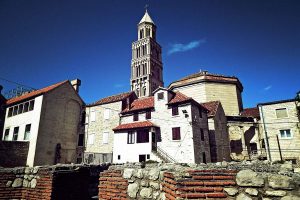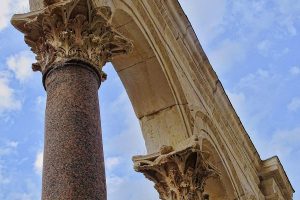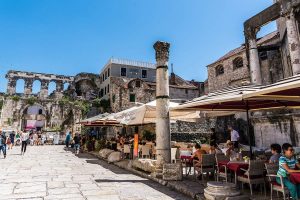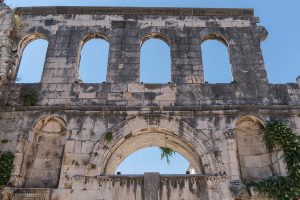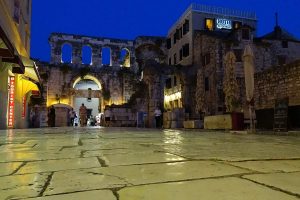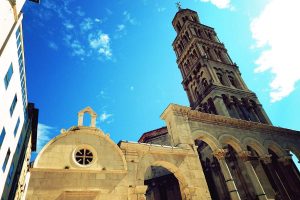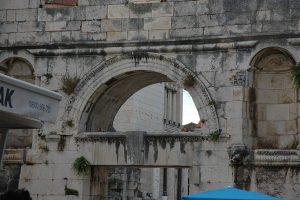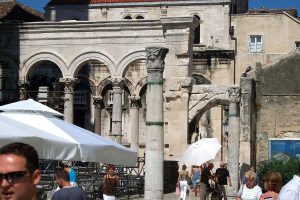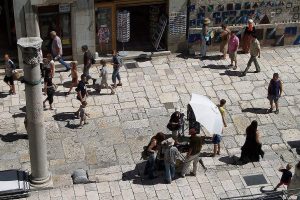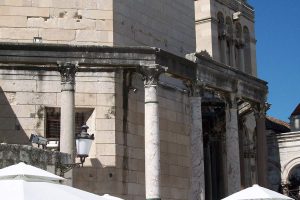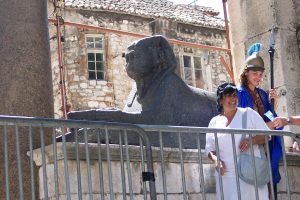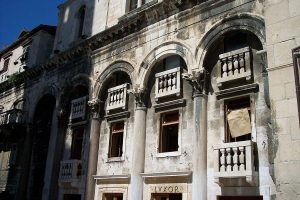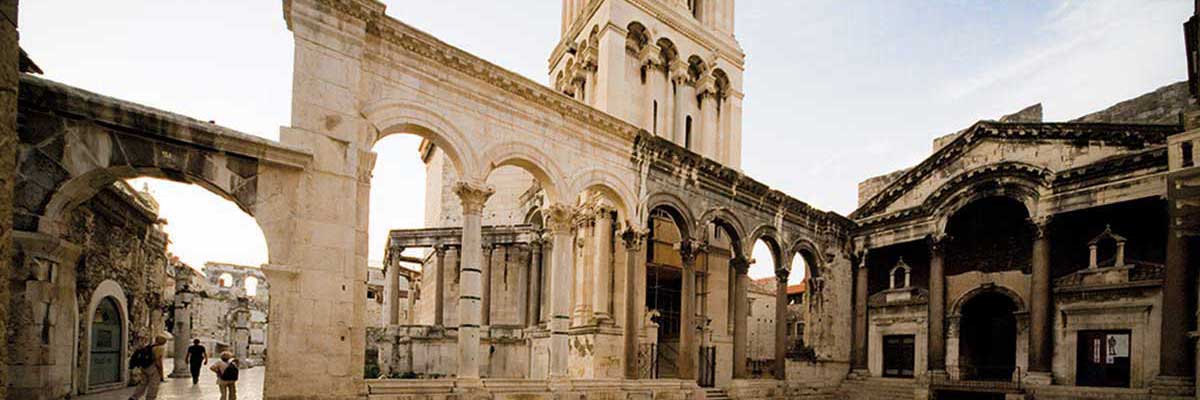
Diocletian’s Palace – Old town of Split
What is the Eiffel tower for Paris or Statue of Liberty for New York, that is Diocletian’s Palace for the city of Split. It is even more than that though. Diocletian Palace is not simply a cultural monument, it is the only living monument in the world as approximately three thousand people still live inside this world heritage site. And, there is no Diocletan’s Palace entrance fee, it is free for everyone.
Diocletian Palace is also a catalyst for the birth of Split as it was the palace that provided shelter to the nearby inhabitants from different invaders throughout the centuries and allowed for Split to prosper and flourish. As the people moved inside the palace they began constructing houses and buildings to house them and eventually the palace became the town itself.
But how did it all came to be? Gaius Aurelius Valerius Diocletianus Augustus, or simply Diocletian, became a Roman emperor in the year 284 AD which he remain to be till the year 305 when he voluntarily gave up the throne. He was the first Roman emperor the voluntarily leave throne in history.
Some 11 years into his reign, in year 295, he ordered the construction of his Palace in the Roman province of Dalmatia near the town Salona (todays Solin), where Diocletian spent time in his youth. The construction of the palace was finished 10 years later, in 305, and as soon as it did, Diocletian decided to abdicate his position as the Roman emperor and he moved to his palace to live the remaining days where he tended to his vegetable gardens.
It is fun to think that Diocletian couldn’t wait to abdicate his role as the emperor as, after all, he was constructing the palace on the most beautiful location in the world (as we like to think) but the truth is a bit different. Diocletian was of poor health and was very much weakened by illness when he decided to leave the imperial office.
It could be that the sulfur springs near Diocletian’s palace (by todays fish market) are the reason Diocletian decided to build on that exact position as sulfur was used in medical treatment of certain bone ailments and was also used for bleaching in textile production which was, by accounts, extremely profitable in those days. Interestingly, there is a clinic next to the fish market, located in marvelous art deco building, which still uses underground sulfur springs in treatments.
Cathedral of St Domnius
Cathedral of St. Domnius is the second oldest structure in the world which is in function as the Christian cathedral, and is regarded as the the oldest Catholic cathedral which remains in use in its original structure, in the entire world.
Relax on the Emperor Square
When you step on the polished stones of the Peristyle, it’s easy to imagine how Diocletian entered with his imperial garments and walked among the cheering crowd.
Under the Sky
In the Roman world, the emperor had a divine origin. In fact, he was the son of Jupiter, the king of the gods. The role of the vestibule was to reinstate this.
The area of the palace, which is shaped as an irregular rectangle, stretches approximately 190 meters in length and around 160 meters in width making the size of Diocletian’s Palace a little over 30,000 square meters. The palace is divided by two main streets (cardo and decumanus) into 4 parts but, looking from the functionality of the palace it is divided into two distinct areas by the decumanus street stretching from west entrance to the palace to its east entrance dividing the palace to its north and south sections.
The south part of the palace was the Diocletian’s villa with the main square called Peristyle, Mausoleum and two temples (round and hexagonal temple which have been destroyed). The north part of the Diocletian’s palace was built as the typical Roman military camp (castrum), area reserved for military, servants and a storage area.
At the end of the two main streets cardo (north-south) and decumanus (east-west) are four gates to the palace. On the east side is the Silver Gate (Porta Orientalis in Roman) protected by two octagonal towers. Entering the Silver gate gets you to the main decumanus street which takes you all the way to the west gate of the palace called the Iron Gate (Porta Occidentalis). Cardo streets which stretches from north where the Golden Gate (Porta septemtrionalis) is located, to the south, through the palace substructures to the Brass Gate (Porta Meridionalis) or sometimes referred to as the Secure gate as they led directly to the sea and made possible to flea by ship when faced by mainland invaders.
The palace is encircled by tall walls and on each corner of the Diocletian palace there was a tower. There were also smaller towers on all walls except for the one facing south to the sea.
Enter the Underworld
They are situated right under the emperor’s quarters and are basically designed as their mirror image. The mirrored floor-plan is not an aesthetic solution, but a practical one as the cellar’s walls, columns and archers support the structure above.
Ancient Temple of Split
Historians have dated the building of the Temple of Jupiter between 295 and 305 AD. It was built as part of the imperial palace’s complex right across the mausoleum – the final resting place of Diocletian.
Discover Imperial Mausoleum
Diocletian’s mausoleum is part of the emperor’s palatial complex in the heart of Split, Croatia. The building, which was constructed at the run of the 4th century AD, is still in use today.
The area where main streets cardo and decumanus intersect is called Peristyle, or the emperor’s square, a place encircled by tall roman columns where nobles would meet and the emperor would make his appearance. In the 13th century the Cathedral of Saint Domnius was built which now dominates Peristyle and the Split’s skyline.
As you follow the cardo street from Peristyle, down the stairs, you enter the Palace substructures or the basements as we like to call them. They were used as a supporting structure for the emperor’s chambers above and structurally they are exact replica of them. This gave historians and archaeologists the unique opportunity to envision and recreate the emperor’s living quarters.
The substructures are the most preserved area of the palace and are also considered to be some of the best preserved ancient structures of that kind in the entire world. They are also the reason that Diocletian’s Palace was included on the UNESCO World Heritage list in 1979.
Today only east part of the substructures is opened for sightseeing but it’s enough to provide an insight into the sheer grandness of the Diocletian’s villa above. Substructures were mainly used as a storage area and provided an exit to the sea which was splashing right on the south walls of the palace all the way to the Brass Gate.
Today Diocletian’s Palace, after over 1,700 years is still booming with life as inside its walls you will find numerous coffee bars, restaurants, nightclubs, shops, museums and witness interesting events throughout the year. Just take a stroll through its many streets and soak in the history of this ancient structure perfectly blending in with today’s world.
What Can You do in a Day?
Many times you end up spending only one day in Split. It doesn’t need to be uneventful, though. Discover what you can do in Split in a single day!
Reveal Hidden Split
We want to tell you about some of the places that quietly stay clear from the limelight and away from the tourist board headlines. They are the places that ooze with urban charm and places where the people are the attraction.
Imperial Complex
The Southern part of Diocletian’s Palace is of major interest to tourists as it is where all the main attractions in the imperial complex are. The list includes the Peristyle, vestibule, cellars, mausoleum and the Temple of Jupiter
Life in the Palace
After all the physical activities that come with experiencing Split, it’s time to indulge in the best of local flavour. Sip on the best Croatian wines in one of town’s wine bars; Zinfandel, Paradox, Diocletian’s Wine House, to name a few. For food, we have rounded up a few must-try eateries tucked into town. On a shoestring budget but want local flavour, try Villa Spiza (Kružićeva 5), run by two sisters who whip up a new menu daily. Pikulece on Dominosova is a tiny tapas joint where a local celebrity chef has crafted a selection of creative bites inspired with local flavour. At the fine-dining end of the spectrum is Restoran Paradigma (Ulica Bana Jelačića 3) who has fabricated Mediterranean cuisine with contemporary flair.
Overdosing on Caffeine – a Truly Local Activity
Meeting friends for coffee is a favorite pastime on the Dalmatian coast and the highlight is a meet-up on Riva, set against the palace’s southern wall. Here, locals get dressed up in high fashion to be seen and stride the length of the seafront promenade before choosing their café of choice, usually Fro, the elite mingling spot. When it starts to get too warm, socializing shifts to the shaded backstreets in cafés like Crème de la Crème (Iličev prolaz 1) for killer coffee and cake, shabby-chic Galerija (Dominisova 9) or nearby Teak (Majstora Jurja 11).
Selection of Bars in Split
The narrow streets of Diocletian’s Palace, the historic core, and suburbs are packed with cafes that convert into bars come nightfall. Find out where the nighlife starts, discover the secret watering holes, or quiet hangouts.
Go out Clubbing!
Start your evening in the crammed café bars within Diocletian’s Palace and Split’s historic core before they close at 1am. When the clock strikes, the party starts in the suburban clubs where you can make noise till sunrise.


